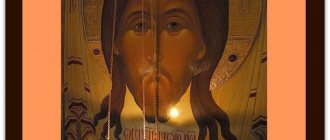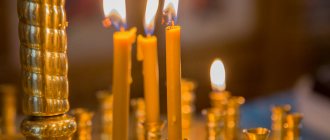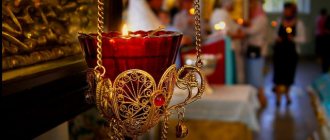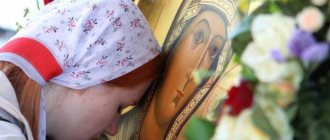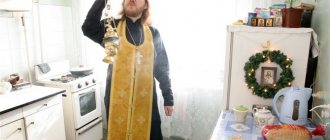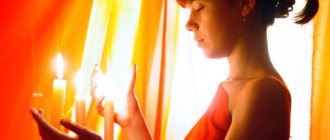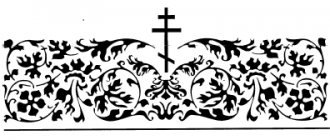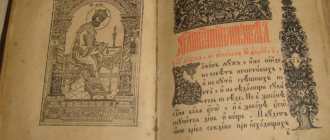Lamps appeared in everyday life at the very dawn of Christianity. Fearing persecution, the first Christians often gathered in caves, where lamps were used for lighting.
But, besides dispersing darkness, the lamp had another purpose. The lamps symbolized the uncreated Light of Christ, without which people seemed to wander in darkness. The tradition of lighting them in front of icons appeared a little later.
Design options for lamps
Most lamps consist of a lamp base and a glass inserted into it, into which oil is poured. This glass, as a rule, is glass, less often – ceramic. Lampstander
made of metal, sometimes of ceramics.
Lamps can be divided into hanging
and
standing
. The first ones are equipped with chains connected at the top. With their help, the lamp is attached to a bracket installed above the icon.
Home
(cell) lamps
, as a rule, differ from temple lamps only in size and sometimes the solemnity of decoration. The church lamp is usually larger than the one that illuminates the home holy corner.
Greek lamps are becoming more and more widespread these days.
. They are essentially miniature oil lamps with a glass cover. Their design is the same as that of kerosene lamps, which are more familiar to residents of our country.
Device
Essentially, a lamp is an improved candle. One option is a container with paraffin, usually a glass (crystal) cup, on a stand. Reusable use is ensured by simple replacement of flammable material. This is typical for desktop products. The stand is metal with a border and figured legs, often decorated with faith. Replaceable cups, different colors:
- red - for Easter time;
- green - for daily use;
- blue, purple or colorless - for Lent.
Supplied with wicks. They can be of different designs:
- A thin plate with a small hole in the middle for a wick. It is placed on the surface of the oil, one end of the wick is above the plate (the length of no more than one or two match heads), the second is lowered into the oil.
- The Greek design is a cork float with a solid wick stuck through it.
The operating principle is the same. The design provides the most comfortable conditions for long-lasting flame maintenance. Wide short candles are used in lamps for religious processions. They are inserted into an oblong-shaped vessel, closed on top with a tin lid with holes. This shape allows the flame to burn long and evenly.
Materials for making lamps
Nowadays, the most common lamps are those with a brass lamp base and chains. In some churches you can also see
silver
lamps - as a rule, they are placed in front of the most revered icons. Porcelain, earthenware, glass and crystal lamps are also very beautiful. Magnificent ancient gold lamps have been preserved in museums.
When purchasing a colored glass cup for a lamp, pay attention to how it is painted. For the highest quality glass, the dye is added to the glass rather than applied on top, which allows it to retain its original appearance for a long time.
Oil
The best oil is considered to be the highest grade Vaseline oil from the Orthodox brotherhood of Ermogen. You can buy it in churches. Any other oil from a temple or church store will also work. The oil must be refined.
You can order lamp oil from our store.
People are also experimenting with olive or sunflower oil. But we haven’t tried this, if you have experience, share it in the comments.
If burning produces fumes, first of all reduce the flame. If this does not help, you should change the oil to another one.
A lamp with good oil can burn around the clock. However, make sure that there are no icons, wood, paper or other flammable surfaces at least 20 cm from the fire. Remember that when a lamp burns, it releases droplets of oil that settle around, making the surfaces of the shelves flammable. Do not place the lamp on the very edge of the shelf.
Features of using different types of lamps
To light the lamp, special lamp oil is used. It can be either plant or chemical in origin.
The most traditional option is natural olive oil, the same oil that has burned in front of icons since ancient times and was considered a pure sacrifice to God. However, this oil smokes quite heavily when using the long wick that is common these days. If you want to burn olive oil in a lamp, it is better to use a special Greek float
, into which a short wick is inserted. Many people prefer to use highly purified vaseline oil in lamps. The oil burning in the lamp, dedicated to God, must be of good quality. In addition, soot from burning low-quality oil pollutes icons and everything around and is harmful to health.
Greek lamps use oil specially intended for them. It is not suitable for use in a regular lamp and, conversely, “Russian” lamp oil will not burn in a Greek lamp.
How to light a lamp correctly
- The wick inserted into the float is pulled to the middle and dipped into the oil with the edge that will then need to be set on fire.
- Pull it out by the dry side so that the edge of the wick stands out by 2 - 3 mm;
- The float is positioned so that the wick is completely immersed in the oil.
- They light the lamp with a flame from a consecrated church candle (it is prohibited to do this with a match or lighter).
Christian traditions associated with the lamp
The lamp should be lit not with a match, but with a church candle. The fire from a lamp is considered sacred - it cannot be used for domestic purposes.
Oil from a lamp burning in front of an icon or other shrine is also holy. They are anointed with it with prayer, believing that the oil has received Divine grace.
unquenchable
lamp
certainly burns . Many believers also do not extinguish the lamps in their homes - however, this tradition is not obligatory.
There is a tradition on Maundy Thursday evening to bring a lighted candle from the church, with which believers stood at the service of the twelve Passionate Gospels, and with this light to light the lamps in the house. Also, on Easter, many people bring the Holy Fire from churches, brought from the Church of the Holy Sepulcher, and light lamps with it.
Lamps are an important part of church decoration. It is a common custom to change the colored cups in them in accordance with the time of the church year: during the Easter period use red ones, during Lent - dark blue or purple, etc.
How to make a lamp
Making it yourself is not at all difficult. First you need to decide on the basis. It can be any kind of tin can, for example, coffee or cookies. The color can also be absolutely any.
So where to start:
- Prepare medium-hard wire and a ballpoint pen.
- Place the rod crosswise on top of the wire. Wrap it with wire to form a spiral, and each curl fits tightly to each other.
- Take out the rod and place the resulting holder exactly in the center of the can on the side of the hole. The protrusion beyond the base should not exceed 0.5 cm.
- Punch small holes on the sides of the jar with an awl through which the holder will pass.
- Pull it through the holes, bending the protruding ends.
To make a wick, you will need a small piece of medical bandage, which must be cut into two equal parts. On one side we tie the resulting strips into a knot, roll them up well and tie them.
We drag the wick into the holder with a thin wire, pulling out 2 cm, and cut out the top knot. Then fill the lamp with oil and carefully light it.
From the history of lamps
The lighting of a lamp in front of the shrine was commanded by God in the Old Testament: “ And the Lord spoke to Moses, saying, Command the children of Israel to bring you pure oil, beaten, for illumination, so that the lamp may continually burn; outside the veil of the ark of the testimony in the tabernacle of meeting, Aaron (and his sons) shall set it up before the Lord from evening to morning always: this is an everlasting statute throughout your generations; They must always set up their lamp on a clean candlestick before the Lord.
"(Leviticus 24: 1-4).
This ritual also passed into Christianity. Lamps were lit during services, and unquenchable lamps burned in front of the most significant shrines.
Before the advent of electric lighting, lamps were of great practical importance: thanks to them, worshipers could see icons in the dark. Actually, lamps were a type of lamps that were also used in everyday life. In front of the most revered shrines, several lamps could be lit - thanks to this, they were visible better than other relics. Expressing their love and reverence, believers donated lamps and oils for them to the icons and relics of saints they revered. Often, when donating a lamp, the benefactor took upon himself the obligation to regularly pay a certain amount for oil. The lamp glowing in front of the shrine became a material expression of prayer. Thus, reading about the “walk” to the Holy Land of Abbot Daniel (12th century), we learn how he lit a lamp in front of the Holy Sepulcher for all of Rus'. And today in the Church of the Holy Sepulchre, lamps from various Local Churches are burning, including from the Russian Orthodox Church.
Artistically made and richly decorated lamps often became contributions to monasteries and temples from rich people and kings. Some of them can still be seen in museums today. Such lamps could be quite large and solemn, decorated with fancy decorative details: tassels, pendants, etc.
Meaning
Lamp from the Greek "lampas" means a portable lamp or a small vessel that contains oil and a wick inside. It is lit in front of the images and the fire does not go out until all the oil is burned.
Initially, the vessels were used simply as lamps, because there was no electricity, and the oil burned out much more slowly than a torch burned out. Such a lamp was used by Christians of the first centuries, since their meetings took place in caves, where it was always dark (persecution did not allow them to gather openly).
As soon as Emperor Constantine allowed Christian services, believers began to hold meetings in churches and the lamp became part of the decorations and attributes of the service. Today it is also used for Christian services in churches.
Interesting! The icon lamp is used by the priest during the liturgy (small and great entrances), as well as during the service of the bishop. The lamp is set on fire by the altar servers or taken to the priest by the deacons.
If initially the vessel was used in worship for its intended purpose - to illuminate a meeting in caves, today it has a more symbolic purpose - it metaphorically depicts the eternal fire of God's love and faith, which drives away the forces of darkness. Twilight in Orthodox churches symbolizes the darkness of human life, and fire is God’s compass, leading people to salvation.
Why are lamps placed in front of the icon?
Since the lamp is a symbol of the eternal flame of God’s love, it must burn constantly in the temple. At home they light it during prayers or for the entire time, provided that there is someone at home. Why this is necessary was explained very well by St. Nicholas of Serbia. He said that faith is light, and the fire in the vessel is a reminder of this light to man.
In addition, the saint identified several more reasons for the need for fire in front of images:
- Fire is a symbol of the bright character of the saints, in front of whose icons lamps are hung.
- The light shows a person the true path, reminding him that every sin leads him further into darkness. By this, the light calls for repentance and gives hope in the darkness.
- This is a sacrifice for God - the Savior gave his life for a person, the least that a person can return is prayer and oil in a lamp.
- This is a symbol of obedience and humility - just as without a person a fire in a lamp cannot be lit, so without God love and repentance will not awaken in a person’s heart.
- This is a symbol of God’s fire in man - Christ said: “Go and shine before men,” comparing man to a lamp.
By lighting a lamp in front of the icons, a person illuminates the faces of the saints, focusing on them and expressing respect. Looking at its fire, people remember God, have a compass and a guide in this dark world.
When should you light a lamp at home?
They are lit during the reading of prayers, on temple holidays and simply at will. In churches they burn continuously, but change depending on the color, which corresponds to the events of the Orthodox calendar:
- red - on temple holidays and Easter week;
- blue - on fasting days;
- yellow (gold) - on everyday days;
- green - on the holiday of Trinity and Palm Sunday.
The tank is initially fixed in front of the image; if it is suspended, then a pin is first driven into the wall that will support the weight of the lamp. Before the prayer begins, the wick of the lamp is lit from a burning church candle and left to burn while the reading takes place.
In addition to prayer moments, the lamp is lit in front of the images on the days of remembrance of the saints who are depicted on the icons, on Sundays and holidays. While lighting the wick, you can read a special prayer:
Light, O Lord, the extinguished lamp of my soul with the light of virtue and enlighten me, Your creation, the Creator and Benefactor. For You are the immaterial Light of the world, accept this material offering: light and fire, and reward me with inner light to the mind and fire to the heart. Amen.
Today you can find lamps of completely different shapes, sizes, types and materials. Its components remain unchanged: an oil reservoir, a stand and a glass to protect the flame. If the lamp is pendant, then most likely it does not have a stand - it is replaced by a decorative element, and there must be three metal cords that hold the tank.
